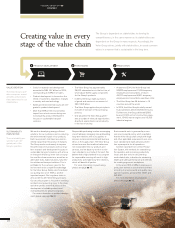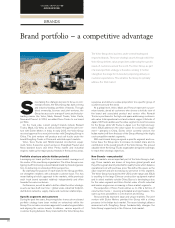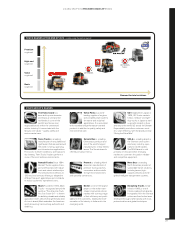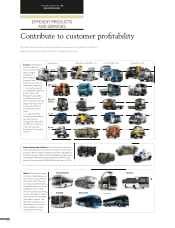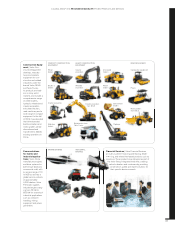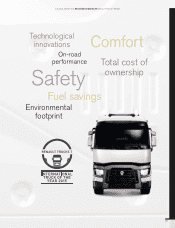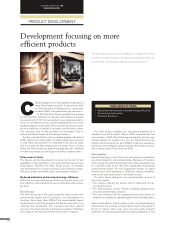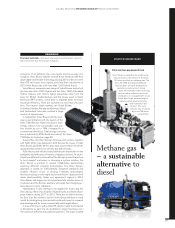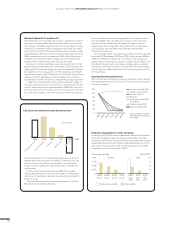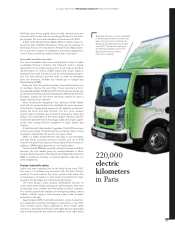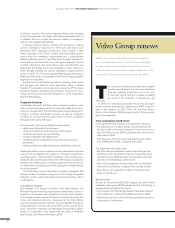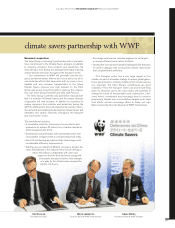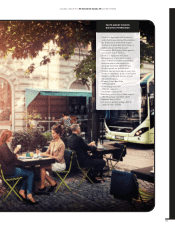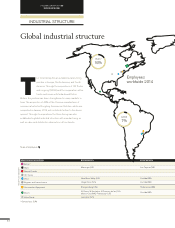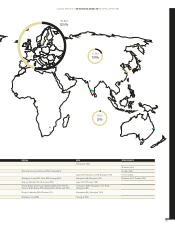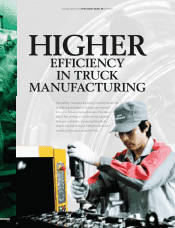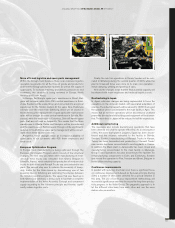Volvo 2014 Annual Report Download - page 42
Download and view the complete annual report
Please find page 42 of the 2014 Volvo annual report below. You can navigate through the pages in the report by either clicking on the pages listed below, or by using the keyword search tool below to find specific information within the annual report.
tion of a certifi cation and reporting legislation. A computer simula-
tion tool, VECTO, that calculates CO2 emissions from new heavy-
duty vehicles has already been developed. The plan is to bring
forward proposals for legislation during 2015 which would require
CO2 emissions from new heavy-duty vehicles to be certifi ed,
reported and monitored.
The overall EU target is that greenhouse gases are to be reduced
by a total of 20% between 2008 and 2030, and by at least 60% by
2050 with 1990 as the base year. The target for city transport is
largely carbon-neutral logistic solutions in major cities by 2030. The
EU states that new vehicle technology includes engines, materials
and design, traffi c planning and use of purer forms of energy through
new drivelines and alternative fuels. All of these are priority areas in
the Volvo Group.
Each new product from the Volvo Group shall have less environ-
mental impact than the product it replaces. The Group uses Life
Cycle Assessments (LCA) to map a product’s environmental
impact in order to make well-informed decisions in the develop-
ment process.
Findings from analyses indicate over 90% of the environ-
mental impact results from the use of the products. The Group’s
main focus is therefore on reducing the environmental impact of
products in use.
The chart above shows the environmental impact of the new
Renault Trucks T 4x2 Euro 6 tractor.
Life Cycle Assessments broaden the perspective
7%28%59%49%
Producing the truck
Fuel consumption
Emissions
Maintenance
–43% 100%
Use Phase
Recycling
Emissions regulations for trucks and buses
In January 2010, EPA 2010 was implemented in North America and at
the end of 2013 Euro 6 was introduced in the EU. With the imple-
mentation of EPA 2010, emission levels for particulates and nitrogen
oxides (NOx) are close to zero. Euro 6 entails that emissions of nitro-
gen oxides and particulate matter are reduced by more than 95%
compared to a truck from the early 1990s.
Signifi cantly reduced emissions
Within the EU all road transport emissions except for carbon dioxide
are expected to decrease in the future. This is the result of stringent
emission regulations.
0
20
60
40
80
120
100
2000
1995
2005
2010
2015
2020
Source: ACEA – European
Automobile Manufacturers'
Association.
Particulate matter (PM)
from diesel
Sulphur dioxide (SO2)
Solvents (VOCs)
Carbon dioxide (CO2 )
Carbon monoxide (CO)
Nitrogen oxides (NOX)
Benzene
2006
Euro 4
2009
Euro 5
2007
EPA
2007
2002
EPA
2002
2014
Euro 6
2010
EPA
2010
8
6
4
2
0
Europe USA
Particulates, g/kWh NOx g/kWh
0.16
0.12
0.08
0.04
02002
Euro 3
Particulates, g/kWh NOx, g/kWh
What will follow US 10 and Euro 6?
The introduction of increasingly strict emission regulations, primarily
focusing on nitrogen oxides and particulate matter, has meant that
the emissions caused by vehicles sold in the market today are at very
low levels. For example, the Euro 6 legislation that came into effect
in the EU at the end of 2013 entails that emission of nitrogen oxides
and particulate matter from new trucks will be reduced by more than
95% compared to a truck from the early 1990s. Volvo Group has a
complete Euro 6 engine program ranging from the smallest medi-
um-duty 5-liter engine to the heavy-duty 16-liter version.
But what is the next step? Rules were introduced in the U.S. that
approximately corresponded to Euro 6 already in 2010. Starting with
model year 2014 greenhouse gas emissions are regulated, followed
by regulations of fuel consumption in 2016, targeting considerable
improvements against a 2010 baseline. All of the Volvo Group’s truck
models in the U.S., both Mack and Volvo branded, are certifi ed in
accordance with 2014 fuel effi ciency and greenhouse gas regulations.
In May 2014, the European Commission presented a strategy on
reducing heavy-duty vehicles’ CO2 emissions. According to the Com-
mission, heavy-duty vehicles represent about 25% of EU road trans-
port CO2 emissions but the emissions are not measured or recorded
as in many other markets. The short-term action will be the introduc-
38
A GLOBAL GROUP 2014 BUSINESS MODEL PRODUCT DEVELOPMENT


